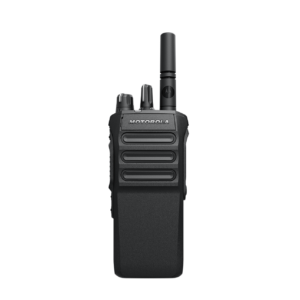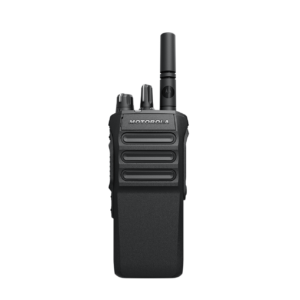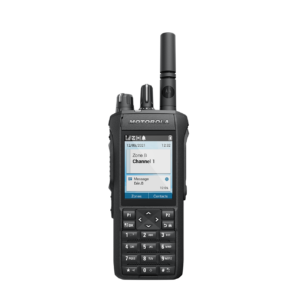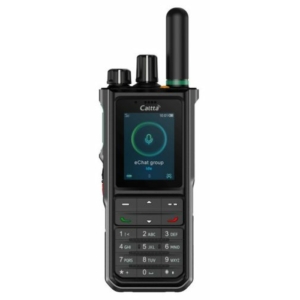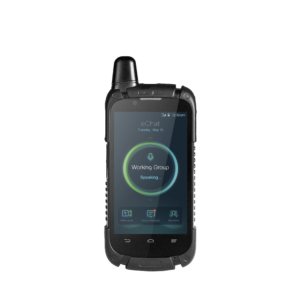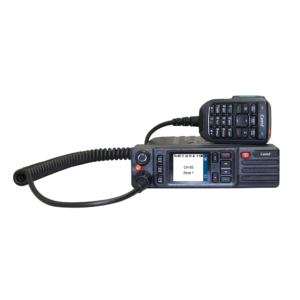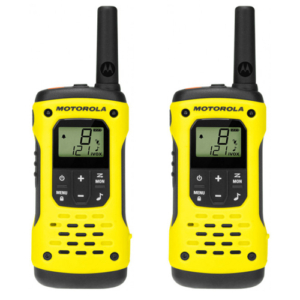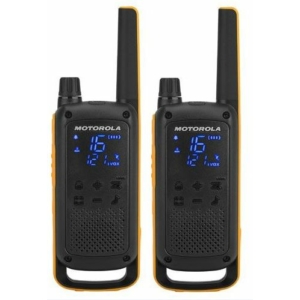Modern transceivers are known for having a number of safety features that not only facilitate the process of calling for help, but also increase safety. Manufacturers are adding a number of great safety features to the basic capabilities of their transceivers, let's look at the most important ones.
PMR446 Walkie Talkies - emergency calls in the Talkabout series
Anico’s portfolio for 2023 includes two hobby walkie talkies featuring emergency call functionality. These are the Motorola Talkabout T82 Extreme and the T92 H2O. The triggering of the emergency call function and the emergency call process itself are identical on the Motorola T82 Extreme and T92 walkie-talkies. Since this function is the same, we will only show how it works on the T92. In the case of the T92 H2O, this button is located on the top of the device: an orange button with a triangle and an exclamation mark. Pressing and holding this button for 3 seconds will start the emergency call protocol. The transceiver initiating the emergency call will emit a siren tone for 8 seconds.

This sound will not only come from the transceiver's speaker, but will also be broadcast on the channel on which the transceiver is located. The other transceivers on the channel that are capable of emergency calls will detect the alarm: volume control is activated, all devices switch to maximum volume. This protocol also applies to muted transceivers.
Emergency alert or emergency call on Motorola R2 and R7 professional transceivers
On the Motorola R2 and R7 transceivers, you can program the device to set an alarm or emergency call function on the specified function keys. The simplest emergency alarm mode is to send an audible alarm. The transceiver, after the user presses the function key programmed for an alarm, emits a tone which is transmitted to the other devices so that everyone can hear the alarm. When the alarm has finished sounding, the user can communicate again with the other users on the channel by pressing the PTT button. There is also the possibility to start transmitting automatically after the alarm has been triggered, so that the person making the emergency call does not need to press the PTT button, but can simply speak as the transceiver indicates. This can be a great help if a user is injured or incapacitated and cannot press the PTT button.
You can also automate the triggering of any emergency call with the lone worker function on Motorola R2 and R7 devices. The function can be configured during basic programming, setting the time after which the device will signal if the operator does not press PTT or change channels. After the set time has elapsed, the pre-programmed alarm or emergency call function is automatically triggered. For Motorola R2, it may be useful to activate the "Search for device" tone in case of an emergency. With this feature, you can remotely control the speaker of the transceiver you want to search for to emit a tone, so if you are lucky, you can hear where the device is. The Motorola R7 already has more settings than its R2 sibling, not only in the communication Wi-Fi and Bluetooth functions, but also in the emergency alerts. Thanks to its fall sensor, it is capable of activating the automatic Man Down signal: if the transmitter's handset is on the ground, the transmitter will trigger the emergency call as pre-programmed. Of course, this can also be fine-tuned with several settings from the CPS program.
In addition, the use of a Honeywell gas detector, which can be connected to the Motorola R7 via Bluetooth, can be a great help in certain work areas. Working within the already deployed Mototrbo system, the R7 transceivers will pick up the gas sensor data and relay it to the central dispatcher. This way, if a critical gas level is detected, the gas detector can automatically send an alarm via the device to the dispatcher, who can then notify the other users. In this way, occupants can quickly escape from a room with high gas levels.

You can read more about this here: Honeywell & Motorola connected safety solutions
Following Motorola's professional transmitters, let's also look at the emergency call features on Caltta devices, mainly because they have more features than Motorola in terms of emergency calling thanks to GPS.
Emergency call functions on Caltta PH series DMR transceivers
The Caltta PH series can be used for both manual and automatic emergency calls. Manual emergency calls can be initiated by pressing and holding the orange button on the top of the unit for 3 seconds. The emergency call function can be configured with different parameters from the CPS program. You can set to which channel the emergency call should go, to automatically start a PTT transmission or to only go through the emergency call. If connected to a dispatching system and repeater, the GPS position is also visible when an alarm is triggered. The dispatcher can be alerted directly, not just other devices on the channel.
The transceivers have an ID that is displayed on the dispatcher console and on other transceivers with a display. This will identify the person giving the alarm. In addition to the manual alarm, the automatic alarm (Man Down) can also be used. In this case, an emergency call is automatically triggered when the transceiver is switched off, based on parameters preset in the CPS program. It is also possible to transmit the exact position of an emergency call without repeater and dispatcher.

For devices with GPS, the GPS DMO function can be used to combine the alarm and manual emergency call on PH660 and PH690. As the position transmission is linked to the pressing of the PTT. When the emergency call is triggered, the GPS position of the transceiver sending the alarm is also transmitted. These can be received by the Caltta PH660, PH690 and PM790 transceivers and the GPS coordinates are displayed on their screens.
In addition to traditional transceivers, the alarm functions of the network transceivers (PoC) are also very interesting.
eChat PoC internet-based transceivers emergency call functions
The eChat internet-based PoC system offers significantly more options for emergency calls than a conventional transceiver. Since the dispatcher receives the emergency call sent by the transceiver, the exact position of the person making the emergency call is immediately visible. The emergency call can be made manually or automatically by the transceiver. To make an emergency call manually, press and hold the orange button on the top of the transmitter for 3 seconds. Only the dispatcher assigned to that transceiver will receive the signal. This is not only done by a red text indicator on the map, but also by a loud warning tone from the dispatch computer's speaker. Thus, both visual and audio warnings are given.
 The emergency call can be cancelled or accepted by the dispatcher. In the latter case, a full duplex call will be initiated with the given device and the parties can communicate without pressing the PTT button. Automatic emergency call initiation can be activated with the Man Down function. This can be done with the eChat e600, e690, e700 and e720 transceivers. This has to be activated in the CPS program or can be switched on and off in the menu of the device.
The emergency call can be cancelled or accepted by the dispatcher. In the latter case, a full duplex call will be initiated with the given device and the parties can communicate without pressing the PTT button. Automatic emergency call initiation can be activated with the Man Down function. This can be done with the eChat e600, e690, e700 and e720 transceivers. This has to be activated in the CPS program or can be switched on and off in the menu of the device.
Another automatic alarm sending mode that is available in all eChat transceivers is the lone worker function. This can be activated by the dispatcher on selected transceivers. It involves setting a timer, after which the transceiver will signal the user to press the PTT button. If the user does not press the PTT button, the device will alert the dispatcher. The dispatcher can then request feedback from the transceiver user or send assistance. This function can also be used, based on practical experience, as a kind of vigilance, as the transceiver will give a mechanical beep to alert the user to press the the button. This can even be useful for drivers on long journeys.
There is also a useful automatic warning system in the eChat system, which can even be used as an emergency alarm in some cases. This is the geo-fencing function, which can help eChat dispatchers to automatically monitor designated zones.

Geo-fencing is a feature that can be used with a dispatching program to draw a virtual fence on the dispatching map. If the transceiver operator leaves or enters this designated area, the unit will signal the dispatch interface. Both visual and audio alerts are sent to the dispatcher.
The audio signal can be turned off in the event of an alarm, but the red signal of the user who activated the alarm remains on the map. When geo-fencing is activated, the device sends an alert to the dispatcher if the device operator has left the zone designated by the dispatcher. The same is true in reverse, so an alarm is also triggered if the user has entered the area. This is a useful feature in places where there is danger to the workers, e.g. mines, but it can also be useful for site security, if you want to make sure that the guard does not leave the area assigned to him.
In the event of an emergency call, you can get information from the injured person not only through the microphone of the transceiver. On the eChat system, you can even see what has happened in the field of view of the transceiver that is sending the alarm for 3 types of devices, but of course the video recall function must be active.Video images can be retrieved by the dispatcher or the designated transceiver operator from the respective devices, e.g. eChat E700, E690, E720.

The main advantage of this feature is that the transceiver operator does not need to allow video retrieval. It is fully automatic when triggered by the dispatcher. This automatic triggering is particularly useful when you need to get information quickly, especially when you need to reach the handset of a person who has become incapacitated after making an emergency call. The video is sent without sound, so you can communicate continuously on the channel you have set up. For devices with two cameras, the front and rear cameras can be switched on. It is also very helpful to be able to share this video image with other users.
To sum up, if you have encountered a situation when buying a transceiver where you might need an emergency alert or distress call, feel free to ask us for advice! We will be happy to help you with programming the relevant functions, but also with thinking through the alarm protocols and selecting the most suitable transceivers for this purpose, with the possibility of a preliminary test run.

